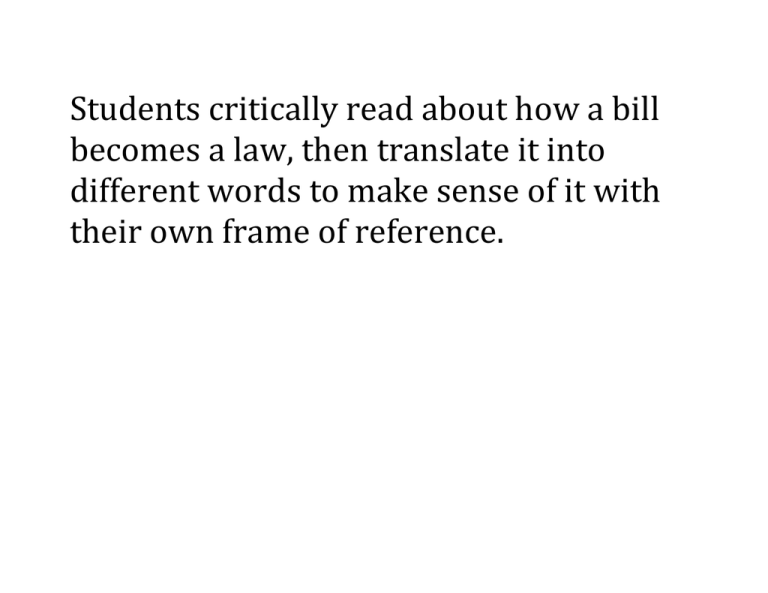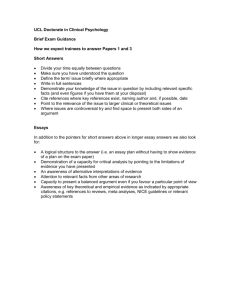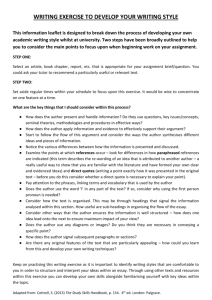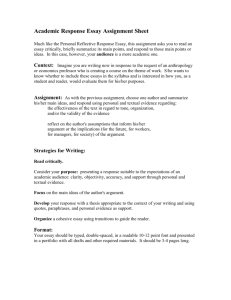Honest Assessment of Skills
advertisement

Students critically read about how a bill becomes a law, then translate it into different words to make sense of it with their own frame of reference. Students summarize the key events leading to Amelia Earhart’s ascent to popularity, using details from a variety of resources to back up what it is that they are saying. After watching a video clip and reading two articles, students plan a field trip to a history museum and prepare an informative essay about Civil War quilts, describing the reasons people made the quilts, and how they were made. Evidence from all three sources are cited in crafting their essay. Using information from two informational articles and a documentary, students write an opinion essay about the different types of climates studied and discuss why they would not want to live in another place. Students read an article about Judicial Review and are then asked to choose statements from the article that support the statement that “Judicial Review is a positive process”. Students take notes during two video clips and two informational readings, then use those notes to write a narrative story from the point of view of George Washington, presenting factual information about Washington and what he was like as a person. Students read a passage about a famous musician then respond to the author’s purpose and resources in writing said biography. Students determine the point of view of John Adams in his “Letter on Thomas Jefferson” and analyze how he distinguishes his position from an alternative approach articulated by Thomas Jefferson. Students provide an objective summary of Frederick Douglass’s Narrative. They analyze how the central idea regarding the evils of slavery is conveyed through supporting ideas and developed over the course of the text. Students trace the line of argument in Winston Churchill’s “Blood, Toil, Tears and Sweat” ad- dress to Parliament and evaluate his specific claims and opinions in the text, distinguishing which claims are supported by facts, reasons, and evidence, and which are not. Students analyze in detail how the early years of Harriet Tubman (as related by author Ann Petry) contributed to her later becoming a conductor on the Underground Railroad, attending to how the author introduces, illustrates, and elaborates upon the events in Tubman’s life. Students determine the figurative and connotative meanings of words such as wayfaring, la- conic, and taciturnity as well as of phrases such as hold his peace in John Steinbeck’s Travels with Charley: In Search of America. They analyze how Steinbeck’s specific word choices and diction impact the meaning and tone of his writing and the characterization of the individuals and places he describes. Students analyze the governmental structure of the U.S. and support their analysis by citing specific textual evidence from primary sources such as the Preamble and First Amendment of the U.S. Constitution as well as secondary sources such as Linda R. Monk’s Words We Live By: Your Annotated Guide to the Constitution. Students evaluate Jim Murphy’s The Great Fire to identify which aspects of the text (e.g., load- ed language and the inclusion of particular facts) reveal his purpose; presenting Chicago as a city that was “ready to burn.” Students describe how Russell Freedman in his book Freedom Walkers: The Story of the Montgomery Bus Boycott integrates and presents information both sequentially and causally to explain how the civil rights movement began Students compare George Washington’s Farewell Address to other foreign policy statements, such as the Monroe Doctrine, and analyze how both texts address similar themes and con- cepts regarding “entangling alliances.” Students analyze how Abraham Lincoln in his “Second Inaugural Address” unfolds his exami- nation of the ideas that led to the Civil War, paying particular attention to the order in which the points are made, how Lincoln introduces and develops his points, and the connections that are drawn between them. Students evaluate the argument and specific claims about the “spirit of liberty” in Learned Hand’s “I Am an American Day Address,” assessing the relevance and sufficiency of the evidence and the validity of his reasoning. Students determine the purpose and point of view in Martin Luther King, Jr.’s, “I Have a Dream” speech and analyze how King uses rhetoric to advance his position. Students compare the similarities and differences in point of view in works by Dee Brown and Evan Connell regarding the Battle of Little Bighorn, analyzing how the authors treat the same event and which details they include and emphasize in their respective accounts. Students analyze the role of African American soldiers in the Civil War by comparing and con- trasting primary source materials against secondary syntheses such as Jim Haskins’s Black, Blue and Gray: African Americans in the Civil War. Students delineate and evaluate the argument that Thomas Paine makes in Common Sense. They assess the reasoning present in his analysis, including the premises and purposes of his essay. Students analyze Thomas Jefferson’s Declaration of Independence, identifying its purpose and evaluating rhetorical features such as the listing of grievances. Students compare and contrast the themes and argument found there to those of other U.S. documents of historical and literary significance, such as the Olive Branch Petition. Students provide an objective summary of Henry David Thoreau’s Walden wherein they analyze how he articulates the central ideas of living simply and being self-reliant and how those ideas inter- act and build on one another (e.g., “According to Thoreau, how specifically does moving toward complexity in one’s life undermine self-reliance?”) Students analyze how the key term success is interpreted, used, and refined over the course of G.K. Chesterton’s essay “The Fallacy of Success.” Students determine Richard Hofstadter’s purpose and point of view in his “Abraham Lincoln and the SelfMade Myth,” analyzing how both Hofstadter’s style and content contribute to the eloquent and powerful contrast he draws between the younger, ambitious Lincoln and the sober, more reflective man of the presidential years. Students determine the central ideas found in the Declaration of Sentiments by the Seneca Falls Conference, noting the parallels between it and the Declaration of Independence and providing a summary that makes clear the relationships among the key details and ideas of each text and between the texts. Students evaluate the premises of James M. McPherson’s argument regarding why Northern sol- diers fought in the Civil War by corroborating the evidence provided from the letters and diaries of these soldiers with other primary and secondary sources and challenging McPherson’s claims where appropriate. Students integrate the information provided by Mary C. Daly, vice president at the Federal Reserve Bank of San Francisco, with the data presented visually in the FedViews report. In their analysis of these sources of information present in diverse formats, students frame and address a question or solve a problem raised by their evaluation of the evidence.






